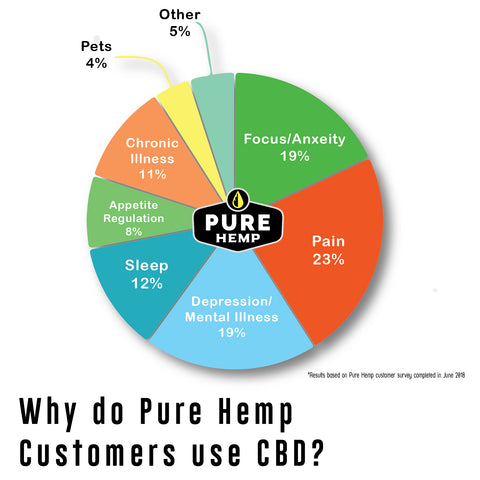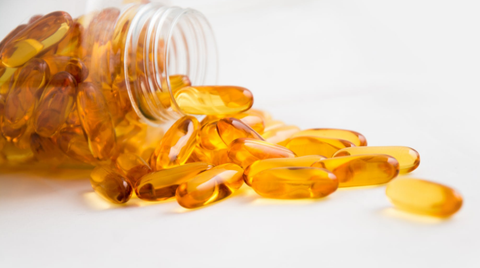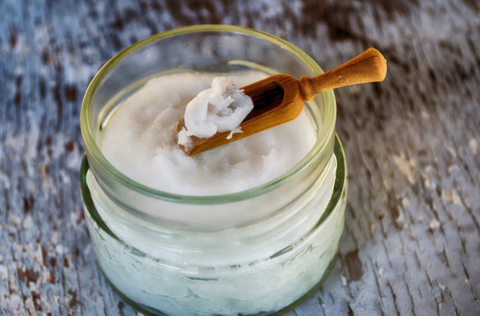
 "The discovery of the endocannabinoid system is the single most important scientific discovery and will save more lives than the discovery and application of surgical anesthesia."
"The discovery of the endocannabinoid system is the single most important scientific discovery and will save more lives than the discovery and application of surgical anesthesia."
Cannabidiol (CBD) is taking the medical world by storm. CBD has become the new buzzword in health.
Unfortunately, like most major medical discoveries, there is a lot of misinformation out there, and "snake oil" brands are popping up. This is your ultimate guide to buying a potent, safe CBD oil that actually works.

Our customers use our products for a variety of different reasons. We were curious about how they use our CBD so we added it to our user satisfaction survey and these are our most recent results as of June 2018.

⚠️🛑⚠️ Since the cannabis industry needs a lot more research, the FTC has made it very clear no CBD oil brand can make claims or promises that a product will be effective for any medical condition. If you see a bunch of promises and claims instead of testimonials. Run.

It is believed the plant species hemp “Cannabis Sativa,” dates back 10,000 years ago and was probably one of the first crops planted by early man. Hemp was first found in what is present-day Taiwan, where farmers used hemp seeds to enrich their soil. Hemp seeds have high levels of protein, vitamins, and essential fatty amino acids.
CBD is a chemical compound derived from the hemp plant. Hemp grows cannabis which has two cannabinoid chemical elements tetrahydrocannabinol (THC) and cannabidiol (CBD).
THC is known for the psychoactive effects or "high". CBD has shot forward recently due to heavy research pouring in showing the massive medical benefits of using CBD (1).
Fun fact, there are now over 1,350 pieces of scientific evidence on the medical uses for CBD with more coming out each month. We’ll be referencing these studies throughout our guide with numbers.

No, CBD is NOT psychoactive like the THC found in cannabis. However, you have to be sure all the THC was safely processed out of the oil. Only use CBD brands that third-party test.

“In humans, CBD exhibits no effects indicative of any abuse or dependence potential,” wrote the World Health Organization, a U.N. agency with a focus on public health. (2, 3)
Addiction is a chronic and often relapsing brain condition in which a person seeks a particular substance, regardless of any harm that might come from it. The most addictive substances on earth have been shown to change the brain’s function over long-term use.
They also heavily and continuously target the brain’s dopamine pleasure centers which are what keeps the addicted person coming back needing that rush of pleasure. CBD products/cannabis does not have these properties.
Unlike most stronger pharmaceutical pain relievers such as Opioids, CBD oil is not addictive.
The human endocannabinoid system (EC) was first discovered in the mid 1975s, but research was quickly shut down due to our nation’s War on Drugs. The EC system uses cannabinoid receptors which work throughout the body to help regulate mood, pain, appetite, liver and muscular function, just to name a few things.
This system includes two cannabinoid receptors CB1 and CB2. CB1 is known to assist with your liver, balance, pleasure and pain tolerances. CB2 has been shown to improve our immune systems. (4, 5, 6)
Your brain communicates through a series of chemical coded messages or neurotransmitters sent to different receptors throughout the body. These messages act as little project managers who regulate how you feel, think and even eat.
The EC system exists to help prevent these receptors from becoming overwhelmed. CBD also helps your body increase a specific cannabinoid called anandamide. Anandamide is responsible for regulating levels of other chemicals found in the brain, including serotonin and dopamine. It boosts without abusing the system like most known addictive substances. (7, 8)
Cannabinoids act as dimmers to these receptors. They help slow and regulate the number of messages being sent because sometimes way too many messages are coming in.
When you receptors are too overwhelmed they will not transmit properly. This could cause any number of health issues.
Stop here, now think about what would happen if that one person at your job who knows everything, runs everything, and does everything got overwhelmed and starting giving out the wrong information? (High-five if that person is you.)
This is what’s happening to your body.
Like many other chemicals your body creates, sometimes we just do not produce enough, especially as you grow older and during times of high-stress when the body shuts down all non-essential functions for long periods of time. CBD helps clear your receptors to get the right messages out at the right times.
There is evidence of many cannabinoid species which focus on different issues, but just like DNA not nearly enough medical evidence is out there to fully understand the importance of the system.
This simple act means CBD can be used to help many issues. Some problems we previously had no idea how to help. Some problems were using too harsh chemicals with awful side effects to control. The possibilities here are endless, but there is still a lot of research to be done and a lot of stigmas to fight.
Legally we cannot make any diseased based claims because not enough research has been completed. Please be wary of any brand that does make unsupported claims. To us the studies speak volumes so please visit our glossary section to learn more about how CBD can help your specific health concerns. (8, 9, 10, 11, 12, 13, 14, 15, 16, 17, 18)
 Not all hemp CBD is equal. Just like wild-caught salmon has more nutrients than farm fed, the cannabinoids derived from cannabis work the same. You get out of it what you put in because it’s bioaccumulator, meaning it pulls from the soil.
Not all hemp CBD is equal. Just like wild-caught salmon has more nutrients than farm fed, the cannabinoids derived from cannabis work the same. You get out of it what you put in because it’s bioaccumulator, meaning it pulls from the soil.
Hemp has to be grown using quality natural nutrients and a lot of sun or hydro light. This is what helps produce quality cannabinoids. The better the grow, the more cannabinoids.
How you decarb the cannabis and remove the THC matter too. To be truly effective in a way that really changes your health the oil needs to have 99% purity.
The industry standard extraction method used is the CO2 method. This is a system where hemp is exposed to high pressures at low temperatures.
This removes the needs for harsh alcohols or chemicals. It’s the safest and cleanest tested method of extraction to date. Watch out for hemp extractors who used harsh solvents like ethanol or butane to remove the oil.
WARNING: Ask for the Testing Paperwork!
Some brands dilute their oils to the point it’s no longer effective. Only buy from brands with third-party tests that use FDA compliant labs to build batches. These are the sources that can be most trusted.
One of the best parts about this CBD oil is it can go into most things so you can really choose the method that works best for your personal needs. This includes how long it lasts, how quickly it activates, and how much is in it.
The CBD oil will either be from the whole hemp plant which is called full spectrum CBD and is known to be the most potent form. You can also use a CBD isolate that is derived from a specific cannabinoid set.
We highly recommend you try different methods because sometimes you need a quick boost and sometimes you need a continuous stream. Let’s go over the basics.

Capsules are by far one of the most widely used methods to consume CBD. Hemp CBD extract is often placed into capsules designed with a longer release time. This allows you to use a single consumption for continuous support throughout the day. This also regulates the amount consumed each time as capsules come in different potencies.
Recommended Users:
- Those looking for extended support with intense pain, muscular or mood management.
- Anyone looking to eliminate the hemp aftertaste.
- Individuals needing to travel with their CBD.
What to Look For:
- Natural veggie CBD capsules
- No filler oils/dilution
- Organically grown hemp

Another popular method to consume CBD is through oils. Oils are taken under the tongue and then swallowed. Oils come in many different forms from full spectrum to specific varieties of cannabinoids and potencies.
Recommended Users:
- Those in need of a higher concentrate.
- Someone looking for an almost instant release.
What to Look for:
- For higher effects use a full spectrum oil.
- Make sure nothing is added, it should be pure.
- Organically grown/ GMO-free

Tinctures are a thinner liquid form of CBD layered with an oil base. Just like the thicker oils this is taken under the tongue and swallowed for a more immediate delivery. Tinctures are often placed in spray bottles for a more travel-friendly process.
CBD brands often pair tinctures with essential oils, vitamins and antioxidants for more targeted results. Pure Hemp offers a variety of these flavorful unique blends. Our Pure Hemp CBD spray line includes support for anti-stress, weight loss, energy boost, and sleep. We also have a line design specifically for pets.
Recommended Users:
- Those wanting targeted results.
- Anyone looking for immediate release as this is fast acting.
- Individuals needing to travel with their CBD.
- Those having difficulty with the natural hemp flavor.
What to Look for:
- A base oil like coconut or grapeseed (avoid vegetable oil bases)
- Trusted trademarked ingredients like SunTheanine
- Check for a proprietary blend
- Non-GMO/no fake flavors

CBD oil can be transformed into flavorful e-liquid which you then vaporize using a pen or ceramic heater. Vaping is one of the most popular methods because of how quickly the cannabinoids absorb into the bloodstream.
Recommended Users:
- If you’re looking for a targeted potency.
- Consumers looking for a wide variety of flavor options.
- Anyone looking for immediate release as this is extremely fast acting.
- Individuals needing to travel with their CBD.
What to Look for:
- Potency no less than 135 mgs per oz.
- CBD isolate for targeted relief.
- A vegetable glycerin base
- No fake flavors or colors (especially red 40 or blue 8)

Beauty and wellness products infused with hemp CBD are quickly becoming popular across America. These are applied topically and absorbed directly into the skin. This is great for targeting pain centers throughout the body.
CBD contains powerful antioxidants equipped to fight damaging free radicals on the skin. One growing concern is the quality of the base beauty product though so be sure to read every ingredient carefully.
Recommended Users:
- Those looking for targeted CBD relief.
- Individuals with skin issues/aging concerns.
- If you need assistance with targeted muscle recovery.
What to Look for:
- Non-GMO, paraben free with only natural dyes.
- No dehydrating alcohols/chemicals.
- Check the potency/purity testing of the end product.
Many consumers cook the CBD directly into their food using a variety of cooking oils or honey. CBD edibles are CBD infused treats such as candy, baked goods and gummies. These typically have less of a potency than traditional methods.
More recently natural CBD hemp-based protein powders are becoming a popular method of consumption for bodybuilders/those looking to maintain a healthy weight.
Recommended Users:
- Those looking for a mild daily maintenance of CBD.
- If you need assistance with targeted muscle recovery.
- Individuals who have a hard time with the hemp taste.
- Sharing with friends :)
What to Look for:
- Non-GMO, paraben free with only natural dyes.
- No dehydrating alcohols/chemicals.
- Check the potency/purity testing of the end product.
CBD Glossary:
Cannabidiol: Cannabidiol is a chemical in the Cannabis sativa plant.
Tetrahydrocannabinol (THC): The physiologically active component in cannabis.
Hemp: A tall plant, Cannabis sativa, that is native to Asia but is cultivated in all over the world.
Cannabis: A tall plant with a stiff upright stem, divided serrated leaves, and glandular hairs. It is used to produce hemp fiber and as a psychotropic drug.
Cannabinoid: Any of a group of closely related compounds that include cannabinol and the active constituents of cannabis.
Decarb: A process for removed carbon to activate the cannabinoids.
Endocannabinoid System: A biological system composed of endocannabinoids.
CB1 Receptor: A G protein-coupled receptor located in the central and peripheral nervous system.
CB2 Receptor: A G protein-coupled receptor from the cannabinoid receptor family that in humans is encoded by the CNR2 gene.
Co2 Extraction: A high pressure/ low-temperature process that uses pressurized carbon dioxide to pull the desired phytochemicals from hemp.
Edibles: Food infused with CBD, such as gummies or protein powders.
Tincture: Hemp CBD liquid extracted which is taken sublingually.
Extraction: The action of removing the cannabinoids and flavors of hemp from the plant parts.
References:
-
https://en.wikipedia.org/wiki/Hemp
-
http://www.who.int/medicines/access/controlled-substances/5.2_CBD.pdf
-
Functional interaction between opioid and cannabinoid receptors in drug self-administration. J Neurosci. 2001;21:5344–5350. [PubMed]
-
The effects of delta1-tetrahydrocannabinol and other cannabinoids on spin-labeled liposomes and their relationship to mechanisms of general anesthesia. | https://www.ncbi.nlm.nih.gov/pubmed/170503
-
Pharmacology of cannabinoid receptor ligands. | https://www.ncbi.nlm.nih.gov/pubmed/10469884
-
Crucial Role of CB2 Cannabinoid Receptor in the Regulation of Central Immune Responses during Neuropathic Pain | http://www.jneurosci.org/content/28/46/12125.long
-
Endovanilloids. Putative endogenous ligands of transient receptor potential vanilloid 1 channels. | https://www.ncbi.nlm.nih.gov/pubmed/15128293/
-
Comparison of anandamide transport in FAAH wild-type and knockout neurons: evidence for contributions by both FAAH and the CB1 receptor to anandamide uptake. | https://www.ncbi.nlm.nih.gov/pubmed/15209515
-
Selective activation of cannabinoid CB2 receptors suppresses spinal fos protein expression and pain behavior in a rat model of inflammation. Neuroscience. 2003a;119:747–757. [PubMed]
-
A peripheral cannabinoid mechanism suppresses spinal fos protein expression and pain behavior in a rat model of inflammation. Neuroscience. 2003b;117:659–670. [PubMed]
-
Activation of cannabinoid CB2 receptors suppresses C-fiber responses and windup in spinal wide dynamic range neurons in the absence and presence of inflammation. J Neurophysiol. 2004;92:3562–3574. [PubMed]
-
Interaction between γ-aminobutyric acid GABAB and cannabinoid CB1 receptors in spinal pain pathways in rat. Eur J Pharmacol. 2005;514:159–164. [PubMed]
-
Increased cannabinoid receptor density in the posterior cingulate cortex in schizophrenia. Exp Brain Res. 2006;172:556–560. [PubMed]
-
The peripheral sympathetic nervous system is the major target of cannabinoids in eliciting cardiovascular depression. Naunyn-Schmiedeberg’s Arch Pharmacol. 2003;367:434–443. [PubMed]
-
A novel inhibitor of androgen-independent prostate cancer cell invasion. Cancer Res. 2004;64:8826–8830. [PubMed]
-
Effects of low-carbohydrate vs low-fat diets on weight loss and cardiovascular risk factors: a meta-analysis of randomized controlled trials. Arch Intern Med. 2006;166:285–293. [PubMed]
-
Therapeutic strategies for rheumatoid arthritis. N Engl J Med. 2004;350:2591–2602.[PubMed]
-
Novel selective and metabolically stable inhibitors of anandamide cellular uptake. Biochem Pharmacol. 2003;65:1473–1481. [PubMed]

 "
"






